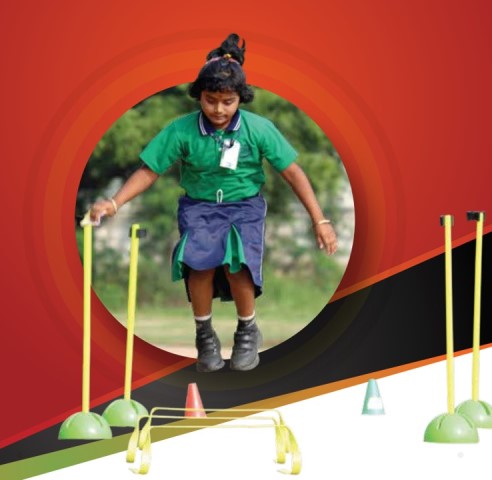INDIA: The 12th Annual Health Survey by Sportz Village, through its award-winning EduSports in-school Physical Education & Sports program, revealed poor fitness levels in most school children across India. The nationwide survey assessed various health parameters like Body Mass Index (BMI), Aerobic capacity, Anaerobic capacity, Core Strength, Flexibility, Upper body strength, and Lower body strength for over 73,000 children in the age groups of 7 years to 17 years from across 250 cities and towns in India.
The survey also showcases that the frequency of weekly Physical Education (P.E.) periods plays a pivotal role in shaping the health of children. The comprehensive data reveals a noteworthy correlation between the number of P.E. sessions per week and various aspects of children’s physical fitness. Remarkably, the survey highlights that children engaging in more than two physical education periods per week exhibit significantly enhanced performance across multiple physical fitness parameters. Improvements are observed in crucial aspects such as Lower Body Strength, Abdominal Strength, Flexibility, and Aerobic Capacity. These findings underscore the positive impact of increased P.E. participation on the holistic well-being of children, emphasizing the importance of incorporating regular physical activity into their routines.
It also reveals notable distinctions in various health metrics between boys and girls. Particularly noteworthy is the observation that a higher percentage of girls exhibit healthier Body Mass Index (BMI) levels, with 62% of girls attaining scores within the healthy range. In contrast, boys show a comparatively lower percentage in this regard.
Further examination of specific physical fitness parameters unveils that girls outperform boys in Flexibility and Upper Body Strength. These findings underscore the positive impact of regular physical activity on these aspects of girls’ health. However, the survey also brings to light areas where boys exhibit stronger performance. Notably, boys demonstrate superior results in Aerobic Capacity and Lower Body Strength. These nuanced insights into gender-specific health indicators emphasize the importance of tailored approaches in promoting overall well-being among both boys and girls.
Commenting on the findings from the Annual Health Survey, Saumil Majmudar, CEO & Managing Director, of Sportz Village, said “At Sportz Village, we are committed to transforming the lives of children through the magic of sports. The Annual Health Survey sheds light on the state of health and fitness among Indian children today – and the current situation is not ideal. There is a tendency for school leaders and parents to view sports & physical education as non-essential and not as important as academics. Hence, less time and energy are devoted to physical activity resulting in poor health of children. Schools need to view sports as an integral part of education and should provide opportunities for children to engage in structured physical activities. Various studies have shown that regular structured physical activity not only improves physical health but also impacts mental health and academic performance. Over the past 15 years, the EduSports program has bridged this gap by integrating into the school timetable and calendar”
Key findings
- The total number of children surveyed 73,000 across India
- 2 in 5 children do not have a healthy BMI
- 2 in 5 children do not possess the desired Anaerobic Capacity
- 3 in 4 children do not have the desired Aerobic Capacity
- 1 in 3 children do not have the desired Abdominal or Core strength
- 3 in 5 children do not have the adequate Upper Body and Lower Body Strength
Fitness levels comparative analysis: Girls versus Boys
According to the survey, the percentage of girls with healthier BMI levels (62% of girls have healthy BMI scores) is more when compared to boys. The girls also fared better in Flexibility and Upper Body Strength. However, they did not fare well in Aerobic Capacity and Lower Body Strength.
Fitness Levels Comparative Analysis: Government Schools versus Private Schools
The survey further reveals, that more children in private schools have better Upper Body Strength levels (43%), compared to the children from government schools (31%). Children from government schools fared better in BMI, Aerobic Capacity & Flexibility.
Fitness levels comparative analysis: Effect of number of P.E periods per week
The survey further shows that children with more than 2 physical education periods per week have significantly better performance in multiple physical fitness parameters such as Lower Body Strength, Abdominal Strength, Flexibility & Aerobic Capacity
Parameters description:
Body Mass Index (BMI): A value derived from the weight and height of an individual and is used to gauge whether a person is within a healthy weight range.
Aerobic capacity: The ability of the heart and lungs to get oxygen to the muscles.
Anaerobic capacity: The total amount of energy from the anaerobic (without oxygen) energy systems. It is useful during high-intensity duration exercises or tasks such as sprinting.
Abdominal or Core strength: The strength of the muscles of the torso which helps to determine posture.
Flexibility: The ability of one’s joints to move freely.
Upper body strength: The strength of muscles such as the Pectorals (chest), Rhomboids (upper back), Deltoids (outer shoulder), Triceps (back of upper arm), and Biceps (front of the upper arm).
Lower body strength: The strength of muscles in the legs such as quadriceps (the muscles on the front of the upper leg), Hamstrings (the muscles on the back of the upper leg), Gluteals, Hip Flexors, and Calf muscles.

